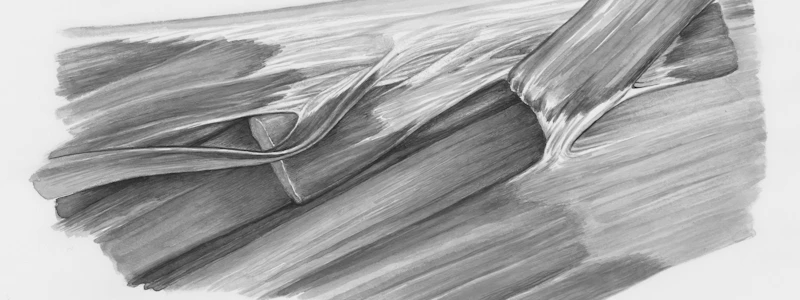Podcast
Questions and Answers
What is the primary focus of gross anatomy?
What is the primary focus of gross anatomy?
- Study of organ systems in detail
- Study of structures visible to the naked eye (correct)
- Study of cellular structures
- Study of tissue types and their functions
Which system is responsible for gas exchange in the body?
Which system is responsible for gas exchange in the body?
- Respiratory system (correct)
- Nervous system
- Cardiovascular system
- Digestive system
What is an essential function of the urinary system?
What is an essential function of the urinary system?
- Hormone production
- Nutrient absorption
- Waste removal (correct)
- Gas transport
Which directional term means 'closer to the trunk'?
Which directional term means 'closer to the trunk'?
What is one function of the skeletal system?
What is one function of the skeletal system?
Which body plane divides the body into anterior and posterior sections?
Which body plane divides the body into anterior and posterior sections?
Which system is responsible for movement and posture?
Which system is responsible for movement and posture?
What is the main function of the endocrine system?
What is the main function of the endocrine system?
Flashcards are hidden until you start studying
Study Notes
Overview of Anatomy
- Anatomy is the branch of biology that studies the structure of organisms.
- It can be divided into:
- Gross Anatomy: Study of structures that can be seen with the naked eye.
- Microscopic Anatomy: Study of structures at the cellular and tissue levels, includes histology and cytology.
Major Anatomical Systems
-
Skeletal System
- Composed of bones, cartilage, and ligaments.
- Functions: support, movement, protection, blood cell production, calcium storage.
-
Muscular System
- Includes skeletal, smooth, and cardiac muscles.
- Functions: movement, posture, heat production.
-
Nervous System
- Divided into central nervous system (CNS) and peripheral nervous system (PNS).
- Functions: sensory perception, thought processing, motor control.
-
Cardiovascular System
- Composed of the heart and blood vessels.
- Functions: transport of nutrients, gases, hormones, and waste.
-
Respiratory System
- Includes the lungs, trachea, bronchi, and diaphragm.
- Functions: gas exchange, oxygen supply, carbon dioxide removal.
-
Digestive System
- Composed of the gastrointestinal tract and accessory organs (liver, pancreas).
- Functions: nutrient breakdown and absorption, waste elimination.
-
Urinary System
- Includes kidneys, ureters, bladder, and urethra.
- Functions: waste removal, fluid balance, electrolyte regulation.
-
Endocrine System
- Consists of glands (e.g., pituitary, thyroid, adrenal).
- Functions: hormone production and regulation of bodily functions.
-
Reproductive System
- Male: testes, prostate, penis.
- Female: ovaries, uterus, vagina.
- Functions: production of gametes, hormone secretion, reproduction.
Anatomical Terminology
-
Directional Terms:
- Superior: above
- Inferior: below
- Anterior (ventral): front
- Posterior (dorsal): back
- Medial: towards the midline
- Lateral: away from the midline
- Proximal: closer to the trunk
- Distal: further from the trunk
-
Body Planes:
- Sagittal: divides body into left and right
- Coronal (frontal): divides body into anterior and posterior
- Transverse (horizontal): divides body into superior and inferior
Importance of Anatomy
- Understanding anatomy is crucial for:
- Medical professionals for diagnosis and treatment.
- Biologists for studying organism functions.
- Educators for teaching biological sciences.
Overview of Anatomy
- Anatomy studies the structure of organisms, categorized into gross and microscopic anatomy.
- Gross Anatomy focuses on structures visible to the naked eye.
- Microscopic Anatomy covers cellular and tissue structures, including histology (study of tissues) and cytology (study of cells).
Major Anatomical Systems
-
Skeletal System:
- Made up of bones, cartilage, and ligaments.
- Functions: provides support, allows movement, protects organs, produces blood cells, stores calcium.
-
Muscular System:
- Comprised of skeletal, smooth, and cardiac muscles.
- Functions: enables movement, maintains posture, generates heat.
-
Nervous System:
- Divided into the central nervous system (CNS) and the peripheral nervous system (PNS).
- Functions: processes sensory information, controls thoughts and motor actions.
-
Cardiovascular System:
- Consists of the heart and blood vessels.
- Functions: transports nutrients, gases, hormones, and waste throughout the body.
-
Respiratory System:
- Includes lungs, trachea, bronchi, and diaphragm.
- Functions: facilitates gas exchange, supplies oxygen, removes carbon dioxide.
-
Digestive System:
- Composed of the gastrointestinal tract and accessory organs like the liver and pancreas.
- Functions: breaks down nutrients, absorbs them, and eliminates waste.
-
Urinary System:
- Includes kidneys, ureters, bladder, and urethra.
- Functions: removes waste, balances fluid levels, regulates electrolytes.
-
Endocrine System:
- Comprised of various glands such as the pituitary, thyroid, and adrenal glands.
- Functions: produces hormones that regulate numerous bodily functions.
-
Reproductive System:
- Male components: testes, prostate, and penis.
- Female components: ovaries, uterus, and vagina.
- Functions: produces gametes, secretes hormones, facilitates reproduction.
Anatomical Terminology
-
Directional Terms:
- Superior: higher location
- Inferior: lower location
- Anterior (ventral): front side
- Posterior (dorsal): back side
- Medial: closer to the midline
- Lateral: farther from the midline
- Proximal: nearer to the trunk
- Distal: farther from the trunk
-
Body Planes:
- Sagittal Plane: divides the body into left and right sections.
- Coronal (Frontal) Plane: separates the body into anterior (front) and posterior (back) parts.
- Transverse (Horizontal) Plane: dissects the body into superior (upper) and inferior (lower) segments.
Importance of Anatomy
- Fundamental for medical professionals for accurate diagnosis and treatment of conditions.
- Essential for biologists in understanding organism functions and structures.
- Valuable for educators in delivering biological sciences effectively.
Studying That Suits You
Use AI to generate personalized quizzes and flashcards to suit your learning preferences.




